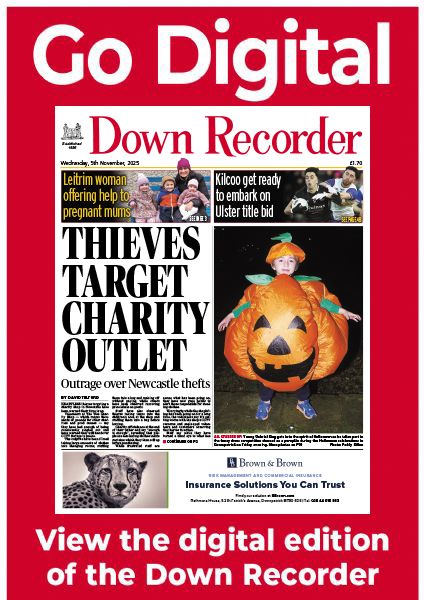Speeder clocked at 95mph
Speeder clocked at 95mph
31 March 2021
STARTLING new figures have revealed that speeding drivers in parts of the district are putting lives at risk.
One driver was clocked travelling at an astonishing 95mph in the 40mph zone at the Strangford Road in Downpatrick, with other speeding hot spots in Castlewellan, Killyleagh and Newcastle.
The outrageous behaviour has been revealed this week by the district’s Policing and Community Safety Partnership, which has installed a series of electronic devices to record drivers’ speed.
Erected as part of a major offensive on speeders, the devices are being hailed a success and more are planned over the coming months.
However, concern remains about the behaviour of some drivers continuing to show a blatant disregard for 30mph and 40mph speed limits in place with the 95mph speed recorded at the Strangford Road described by one local politician as “horrific”.
Residents in the built-up area — which includes a significant number of houses, a nursing home and local authority depot — have continually expressed concern about the speed of drivers who use the busy road.
Their anxiety will be heightened with confirmation that 28 drivers were clocked travelling over 70mph in the 40mph zone between January 6 and March 11 this year.
The highest number of speeding violations at the Strangford Road were recorded around 7am.
Elsewhere, one driver was detected travelling at 83mph in the 30mph zone at the Dublin Road in Castlewellan where 10 drivers were detected at over 70mph. The highest number of offences were recorded at 6am.
In Killyleagh, a driver was detected travelling at 82mph in the 30mph zone on the approach to the town’s Integrated primary school, with 33 drivers clocked at over 70mph and the highest number of offences recorded at 5pm.
The highest speed recorded at the Dublin Road in Castlewellan was 83mph, with 10 drivers detected travelling at over 70mph, while at Newcastle’s South Promenade, the highest speed recorded in the 30mph zone was 67mph.
The speeding figures were due to be discussed at last night’s online meeting of the Policing and Community Safety Partnership (PCSP) when politicians were told that there has been an average reduction of 10% in speed recorded by the electronic devices at seven areas across the district, including Camlough, Meigh and Rostrevor. The highest recorded speed was an eye-watering 106mph at Camlough.
The number of drivers detected travelling at 70mph over the past three months by the seven speed indicator devices has reduced from 512 during April, May and June to 454 — a reduction of 11.5%. The average percentage of cars travelling in excess of 35mph has also decreased slightly.
Additional speed indicators are due to be erected at the Dundrum Road in Clough, Downpatrick Road in Ardglass and Ballynahinch’s Saintfield Road, with the PCSP planning to install seven more during the new financial year.
But demand for the devices is high with a total of 37 requests lodged with the PCSP for them to be provided in the Downpatrick, Rowallane, Slieve Croob and Mournes district electoral areas.
South Down MLA Colin McGrath and Mournes councillor Willie Clarke have expressed concern that some drivers are continue to speed in built-up areas but have welcomed confirmation that overall, speeding in a number of hot spot areas is decreasing.
Mr McGrath described the speeds recorded at the Strangford Road in Downpatrick as “horrific and chilling”.
He continued: “What if a local resident or child was to step onto this busy road? The footpaths are narrow in places, the lighting in the area is poor and residents are at times walking and driving in fear for their lives.
“Such high speeds will not help allay their fears and I will be writing to the PSNI and asking for regular speed checks on this road to regulate the speed and ensure residents’ safety.”
Cllr Clarke said while some of the speeds are very worrying, he said the data recorded by the speed indicator devices provides police with the information about where they need to be and at what time to catch those who are breaking the law and putting other road users and pedestrians at risk.
“I welcome the reduction in speed which the data reveals, but more needs to be done. Police now have the data they need to catch offenders and this is something that many people want to see happening,” he continued.
Cllr Clarke said the Department for Infrastructure also has a role to play in helping address the speeding issue.
“The speed devices are having an impact and with plans for many more across the district, it is important that the critical data they provide will enable the authorities to apprehend those who are not only breaking the law, but placing themselves, other road users and pedestrians at risk,” he added.


